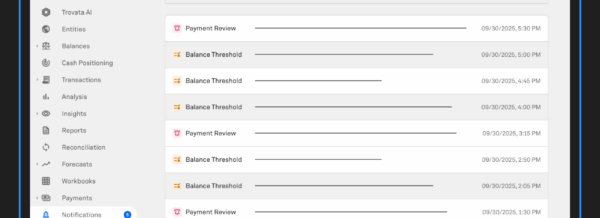The purpose of cash flow analysis is to understand how cash moves in and out of an organization, enabling decisions that better support business operations. Treasurers have unique visibility into available cash—including virtual accounts, regular accounts, assets, and liabilities— as well as historical and seasonal trends in how cash moves through the business.
This direct view, combined with a treasurer’s expertise in business cash management, can result in better utilization of a company’s cash. It can also identify risks that might be missed in other, more indirect, approaches.
By combining what they know about the business, the marketplace in which they work, and their expertise in cash management, treasurers have a unique perspective on:
- Where cash will be leaving the company in the future
- How cash will be arriving in the future
The historical data and future-forward examination of company cash flow result in valuable insights that are only available from comprehensive, timely treasury management practices and technologies.
Treasurer’s Cash Flow Analysis and Visibility
Treasury has direct visibility into unique data: virtual bank accounts, traditional bank accounts, global and regional bank balances, investments, and more. The functional snapshot of a business’s operating cash is made by the treasurer.
When analyzing cash flow, treasurers are well-positioned to take into account historical cash flow. This perspective can identify trends in financing activities, operating cash flow, capital expenditures, and global or regional collections. Combined with a treasurer’s experience and understanding of the business, these historical cash flow trends can, through better forecasting, inform better cash management decisions.

Cash Flow Analysis and Timing – Why Having Unified Bank Data Is Critical
Treasurers are focused on doing one thing extremely well: knowing how much cash they have, and forecasting it accurately in the future. Due to the importance of ensuring bank accounts have the funds required to fulfill obligations like payroll or debt repayment, treasurers work towards having a real-time perspective on cash flow.
The first view of global cash activity for the organization comes from the treasury department right when money enters or leaves a bank account. Contemporary tools for treasury measurement put this information in the treasurer’s hands, first—before accounting or other financial professionals.
Using these tools, a treasurer can:
- Forecast cash flow at daily, weekly, or monthly intervals
- Automate the aggregation and normalization of bank data across global bank accounts with bank APIs
- Perform regular cash flow variance reporting
With these tools in their arsenal, a treasurer can make better decisions on investments and allocations, free staff to focus on identifying opportunities instead of getting bogged down in data collection, and quickly investigate any large variances to adjust forecasts accordingly.
Importantly, the real-time perspective of treasury results in better timing of when cash will be available to the company. This can spur collaborations with accounts receivable or accounts payable to take advantage of available opportunities without lagging behind for the month-end accounting statements.
A Direct Approach To Cash Flow Analysis
By measuring cash flow directly in real-time, treasurers guard against typical common cash flow management errors Here are four common cash management errors and how treasurers help mitigate risk for your business:
- Lack of experience in cash management. Treasurers are specialized in cash flow management and hold the business portfolio for managing cash for the business.
- Failure to grasp the cash flow cycle. Treasurers observe cash flow directly, as it occurs, and are intimately concerned with understanding and optimizing that cycle.
- Mistaking profit for cash. Treasurers are making decisions while looking directly at the cash on hand, so they can guard against spending money that hasn’t yet cleared the bank.
- Bad investments. A treasurer knows when an investment generates cash.
Without guarding against the above situations, a company’s understanding of cash flow will be incomplete at best. A treasurer’s perspective will greatly improve the analysis and the resulting ability to seize opportunities.
Conclusion
Treasury’s function–to execute the capital allocation strategy–refines a perspective that is comprehensive, real-time, and direct. Measuring real performance vs. actual bank statements increases the assurance of internal decision-makers and external stakeholders. When decision-makers have clear and timely analysis, they can shorten cash conversion cycles and improve free cash flow or take advantage of opportunities to ease future cash flow pressures.
Download the Essential Treasury Reporting and Forecasting Guide to learn how Trovata can help you strengthen your liquidity strategy.




